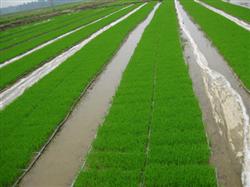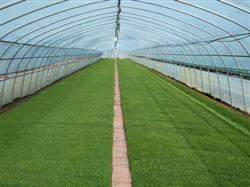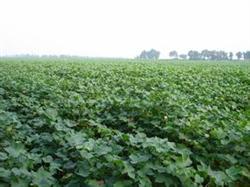How to apply fertilizer to rice seedlings during the stinging period

"Spring thunder rings, all things grow". Since ancient times, our country has attached great importance to stinging solar terms, and many agricultural activities are about to begin, and the most important agricultural work is "planting seedlings." The stinging season enters the season of raising rice seedlings, as the saying goes, "half of the rice seedlings are good". In order to obtain high yield of rice, we must first cultivate a sufficient number of strong seedlings, and fertilization in the seedling field is an important measure to cultivate strong seedlings. The purpose of fertilization management in rice seedling field is to cultivate strong seedlings. The basic characteristics of strong rice seedlings are as follows: strong and straight leaves, bright green leaves, flat cattail at the base, developed roots, many white roots and tillers. In view of the short seedling age of early and middle rice, low temperature during seedling raising, slow release of soil nutrients and slow decomposition of fertilizer, attention should be paid to the application of high quality farm manure after maturity and decomposition, and then appropriate amount of chemical fertilizer should be used as basic fertilizer in seedling field. In the principle of chemical fertilizer application, nitrogen fertilizer should be controlled. For the seedling fields with high soil fertility, we should apply less nitrogen fertilizer and appropriately increase the amount of phosphate and potassium fertilizer, that is, using low nitrogen, high phosphorus and medium potassium compound fertilizer to raise seedlings, and must not use high nitrogen compound fertilizer to raise seedlings; pay attention to the application of phosphate fertilizer (such as calcium superphosphate or calcium magnesium phosphate fertilizer 30-40kg per mu) and potassium fertilizer (10kg potassium chloride per mu) The basic fertilizer of seedling field can not be applied nitrogen in high fertility soil, but less nitrogen fertilizer can be applied in general fertility soil, which is controlled at about 3 kg per mu. This can reduce the possibility of rotten seedlings in the rice seedling field, and is conducive to the cultivation of strong seedlings. In the seedling field with zinc deficiency in soil, 1 kg of zinc sulfate per mu was mixed with organic fertilizer to make the top fertilizer of the seedling field. Zinc fertilizer must be applied evenly. In the later stage of the seedling field, that is, 3-4 days before pulling seedlings, nitrogen fertilizer can be used as starting fertilizer, which is called "marriage fertilizer" by the masses. Fertilization in late rice seedling field due to high air temperature and mud temperature, in order to prevent seedling growth, late rice seedling field is more suitable to use slow and lasting farm manure, and the application rate of phosphate fertilizer is slightly less than that in early and middle rice seedling field. 25-30 kg of calcium superphosphate or 25-30 kg of calcium magnesium phosphate per mu. Potash fertilizer is very important for raising seedlings of late rice. The application of potassium fertilizer can prevent flax leaf spot and brown spot of seedlings. It is appropriate to apply 8-10 kg potassium chloride as flour fertilizer per mu of late rice. More attention should be paid to the application of nitrogen fertilizer, with or without nitrogen fertilizer, in order to control the growth of seedlings. 4-5 days before transplanting, urea 2-3 kg or ammonium bicarbonate 8-10 kg per mu was applied to ensure the good development of new roots and accelerate the rejuvenation of grain seedlings.
- Prev

Dry Seedling raising technique of Rice Bowl in large and medium greenhouse
(1) seed selection. Heavy varieties of partial panicle with high quality, high yield, disease resistance and middle and high tillering ability should be selected. Wuyou Dao 1, Songjing 2, Tengxian 140, Wudao 3, Mudanjiang 19 were selected as the main varieties in the first accumulated temperature area, while Ning'an, Fangzheng, Yanshou and Betula platyphylla were selected in the second accumulated temperature area.
- Next

It is necessary to master key techniques to grow cotton well.
If you want to grow cotton well, you should master the following key techniques. First, strictly control the sowing quality. 1. Select high-quality and high-yield varieties. Select the excellent varieties promoted by the local agricultural technology department. 2. Sow seeds before sowing. On a sunny day, spread the seeds on non-cement ground and sow them in the sun for 5 days to promote seed ripening.
Related
- The first cup of black tea in spring, the flavor and history of tea gardens in Kenya, Africa
- The computer can not only choose potatoes, but also grow tea rice. AI will grow winter oolong tea champion.
- It is not only the inflated tea bitten by insects, but also engraved with the four seasons tea in Beipu.
- The Oriental Beauty Tea Festival in Zhuxian County takes the stage at the weekend to experience the plus-size feast of oil tea.
- & quot; Oriental Beauty Tea & Exploration of Emei in Hsinchu, the hometown of quot;
- The new variety of strawberry "Tainong 1" dessert is the first choice with mellow aroma. Crimson gorgeous
- History of Tea in Taiwan: from Wild Inner Mountain to Export Tea Garden
- Two types of Taiwan Oriental Beauty Black Tea won the British three-Star Award for Childhood Tea Xiang Zhang Jiaqi changed from pilot to champion tea maker.
- Banana species and varieties: the planting history of Taiwan Xianren banana and dwarf banana is long, is banana disease resistant?
- Coffee planting Technology: Qianjie Coffee from Seedling to harvesting

